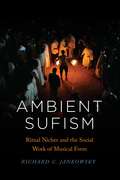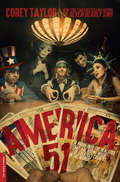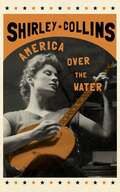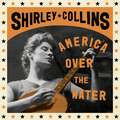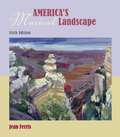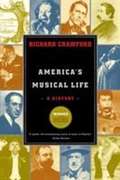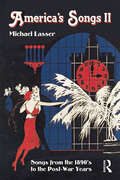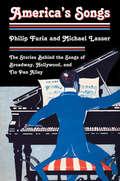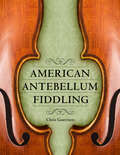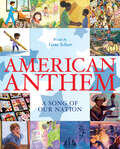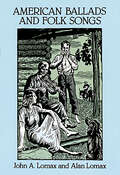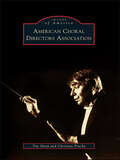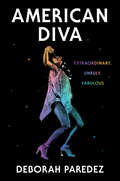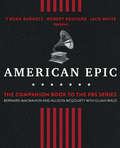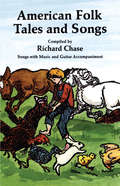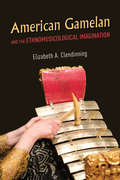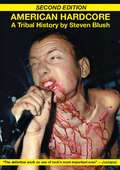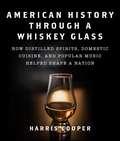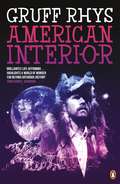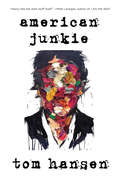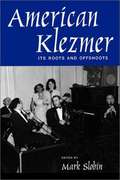- Table View
- List View
Ambient Sufism: Ritual Niches and the Social Work of Musical Form (Chicago Studies in Ethnomusicology)
by Richard C. JankowskyAmbient Sufism is a study of the intertwined musical lives of several ritual communities in Tunisia that invoke the healing powers of long-deceased Muslim saints through music-driven trance rituals. Richard C. Jankowsky illuminates the virtually undocumented role of women and minorities in shaping the ritual musical landscape of the region, with case studies on men’s and women’s Sufi orders, Jewish and black Tunisian healing musical troupes, and the popular music of hard-drinking laborers, as well as the cohorts involved in mass-mediated staged spectacles of ritual that continue to inject ritual sounds into the public sphere. He uses the term “ambient Sufism” to illuminate these adjacent ritual practices, each serving as a musical, social, and devotional-therapeutic niche while contributing to a larger, shared ecology of practices surrounding and invoking the figures of saints. And he argues that ritual musical form—that is, the large-scale structuring of ritual through musical organization—has agency; that is, form is revealing and constitutive of experience and encourages particular subjectivities. Ambient Sufism promises many useful ideas for ethnomusicology, anthropology, Islamic and religious studies, and North African studies.
Ambient Sufism: Ritual Niches and the Social Work of Musical Form (Chicago Studies in Ethnomusicology)
by Richard C. JankowskyAmbient Sufism is a study of the intertwined musical lives of several ritual communities in Tunisia that invoke the healing powers of long-deceased Muslim saints through music-driven trance rituals. Richard C. Jankowsky illuminates the virtually undocumented role of women and minorities in shaping the ritual musical landscape of the region, with case studies on men’s and women’s Sufi orders, Jewish and black Tunisian healing musical troupes, and the popular music of hard-drinking laborers, as well as the cohorts involved in mass-mediated staged spectacles of ritual that continue to inject ritual sounds into the public sphere. He uses the term “ambient Sufism” to illuminate these adjacent ritual practices, each serving as a musical, social, and devotional-therapeutic niche while contributing to a larger, shared ecology of practices surrounding and invoking the figures of saints. And he argues that ritual musical form—that is, the large-scale structuring of ritual through musical organization—has agency; that is, form is revealing and constitutive of experience and encourages particular subjectivities. Ambient Sufism promises many useful ideas for ethnomusicology, anthropology, Islamic and religious studies, and North African studies.
Ambient Sufism: Ritual Niches and the Social Work of Musical Form (Chicago Studies in Ethnomusicology)
by Richard C. JankowskyAmbient Sufism is a study of the intertwined musical lives of several ritual communities in Tunisia that invoke the healing powers of long-deceased Muslim saints through music-driven trance rituals. Richard C. Jankowsky illuminates the virtually undocumented role of women and minorities in shaping the ritual musical landscape of the region, with case studies on men’s and women’s Sufi orders, Jewish and black Tunisian healing musical troupes, and the popular music of hard-drinking laborers, as well as the cohorts involved in mass-mediated staged spectacles of ritual that continue to inject ritual sounds into the public sphere. He uses the term “ambient Sufism” to illuminate these adjacent ritual practices, each serving as a musical, social, and devotional-therapeutic niche while contributing to a larger, shared ecology of practices surrounding and invoking the figures of saints. And he argues that ritual musical form—that is, the large-scale structuring of ritual through musical organization—has agency; that is, form is revealing and constitutive of experience and encourages particular subjectivities. Ambient Sufism promises many useful ideas for ethnomusicology, anthropology, Islamic and religious studies, and North African studies.
Ambisonics: A Practical 3D Audio Theory for Recording, Studio Production, Sound Reinforcement, and Virtual Reality (Springer Topics in Signal Processing #19)
by Franz Zotter Matthias FrankThis open access book provides a concise explanation of the fundamentals and background of the surround sound recording and playback technology Ambisonics. It equips readers with the psychoacoustical, signal processing, acoustical, and mathematical knowledge needed to understand the inner workings of modern processing utilities, special equipment for recording, manipulation, and reproduction in the higher-order Ambisonic format. The book comes with various practical examples based on free software tools and open scientific data for reproducible research.The book’s introductory section offers a perspective on Ambisonics spanning from the origins of coincident recordings in the 1930s to the Ambisonic concepts of the 1970s, as well as classical ways of applying Ambisonics in first-order coincident sound scene recording and reproduction that have been practiced since the 1980s. As, from time to time, the underlying mathematics become quite involved, but should be comprehensive without sacrificing readability, the book includes an extensive mathematical appendix. The book offers readers a deeper understanding of Ambisonic technologies, and will especially benefit scientists, audio-system and audio-recording engineers.In the advanced sections of the book, fundamentals and modern techniques as higher-order Ambisonic decoding, 3D audio effects, and higher-order recording are explained. Those techniques are shown to be suitable to supply audience areas ranging from studio-sized to hundreds of listeners, or headphone-based playback, regardless whether it is live, interactive, or studio-produced 3D audio material.
America 51: A Probe into the Realities That Are Hiding Inside "The Greatest Country in the World"
by Corey TaylorA skewering of the American underbelly by the New York Times bestselling author of Seven Deadly Sins, A Funny Thing Happened on the Way to Heaven, and You're Making Me Hate YouThe always-outspoken hard rock vocalist Corey Taylor begins America 51 with a reflection on what his itinerant youth and frequent worldwide travels with his multiplatinum bands Slipknot and Stone Sour have taught him about what it means to be an American in an increasingly unstable world. He examines the way America sees itself, specifically with regard to the propaganda surrounding America's origins (like a heavy-metal Howard Zinn), while also celebrating the quirks and behavior that make a true-blue American. Taylor likewise takes a look at how the world views us, and his findings should come as a surprise to no one. But behind Taylor's ranting and raving is a thoughtful and intelligent consideration, and even a sadness, of what America is compared to what it could and should be.Expertly balancing humor, outrage, and disbelief, Taylor examines the rotting core of America, evaluating everything from politics and race relations to modern family dynamics, millennials, and "man buns." No element of what constitutes America is safe from his adept and scathing eye. Continuing the wave of moral outrage begun in You're Making Me Hate You, Taylor flawlessly skewers contemporary America in his own signature style.
America Over the Water
by Shirley Collins'Shirley is a time traveller, a conduit for essential human aches, one of the greatest artists who ever lived' Stewart Lee'Without doubt one of England's greatest cultural treasures' Billy BraggIn America Over the Water, celebrated English folksinger Shirley Collins offers an affecting account of her year-long stint as assistant to legendary musical historian and folklorist Alan Lomax. Together, they travelled to Virginia, Kentucky, Alabama, Mississippi, Arkansas, and Georgia, encountering Mississippi Fred McDowell, Muddy Waters and many others, in their tireless work to uncover the traditional music of America's heartland. Blending the personal story of Shirley Collins' relationship with Lomax and offering a unique first-hand account of a country on the brink of the civil rights era, America Over the Water cuts right to the heart of the blues in a fascinating account of Collins' and Lomax's ground-breaking journey across the southern states of the USA to record the music that started it all. Originally published over fifteen years ago, this definitive edition includes a new introduction by Shirley Collins.
America Over the Water
by Shirley Collins'Shirley is a time traveller, a conduit for essential human aches, one of the greatest artists who ever lived' Stewart Lee'Without doubt one of England's greatest cultural treasures' Billy BraggIn America Over the Water, celebrated English folksinger Shirley Collins offers an affecting account of her year-long stint as assistant to legendary musical historian and folklorist Alan Lomax. Together, they travelled to Virginia, Kentucky, Alabama, Mississippi, Arkansas and Georgia, discovering Mississippi Fred McDowell and many others, in their tireless work to uncover the traditional music of America's heartland. Blending the personal story of Shirley Collins' relationship with Lomax and offering a unique first-hand account of a country on the brink of the civil rights era, America Over the Water cuts right to the heart of the blues in a fascinating account of Collins' and Lomax's ground-breaking journey across the southern states of the USA to record the music that started it all. Originally published over fifteen years ago, this definitive edition includes a new introduction by Shirley Collins.
America Over the Water
by Shirley CollinsIn America Over the Water, celebrated English folksinger Shirley Collins offers an affecting account of her year-long stint as assistant to legendary musical historian and folklorist Alan Lomax. Together, they travelled to Virginia, Kentucky, Alabama, Mississippi, Arkansas and Georgia, discovering Mississippi Fred McDowell and many others, in their tireless work to uncover the traditional music of America's heartland. Blending the personal story of Shirley Collins' relationship with Lomax and offering a unique first-hand account of a country on the brink of the civil rights era, America Over the Water cuts right to the heart of the blues in a fascinating account of Collins' and Lomax's ground-breaking journey across the southern states of the USA to record the music that started it all. Originally published over fifteen years ago, this definitive edition includes a new introduction by Shirley Collins.
America's Musical Landscape
by Jean FerrisThis textbook for music appreciation undergraduates surveys American music, relating it to the other arts and social and cultural contexts. Ferris (music history and appreciation, Arizona State U.) first explains the elements of music, then takes the reader on a chronological tour of American music, from North American Indian and folk music to contemporary mainstream concert music. Along the way, religious and secular music are discussed, as well as nineteenth century popular and concert music; country, folk, jazz, Latin music, and rock and roll; and musical theater, film music, and American opera. Listening charts are incorporated. This edition has been updated and reorganized, the amount of vernacular music has been expanded, and the recordings have been updated to match. Timelines are also new. No bibliography is provided. Annotation ©2006 Book News, Inc., Portland, OR (booknews.com)
America's Musical Life: A History
by Richard CrawfordAn Introduction to America's Music tells the fascinating story of music in the United States, from the sacred music of its earliest days to the jazz and rock that enliven the turn of the millennium. Beginning with the music of Native Americans and continuing with traditions introduced by European colonizers and Africans brought here as slaves, the book reveals how this bountiful heritage was developed and enhanced in the nineteenth and twentieth centuries to produce the music we hear today.
America's Songs II: Songs from the 1890s to the Post-War Years
by Michael LasserAmerica’s Songs II: Songs from the 1890's to the Post-War Years continues to tell the stories behind popular songs in our country’s history, serving as a sequel to the bestselling America’s Songs: Stories Behind the Songs of Broadway, Hollywood, and Tin Pan Alley. Beginning in 1890 and ending in post-war America, America's Songs II is a testament to the richness of popular music in the first half of the 20th century. This volume builds on the unique features of the first volume, delving deeper into the nature of the collaboration between well-known songwriters of the time but also shedding light on some of the early performers to turn songs into hits. The book’s structure – a collection of short easy-to-read essays – allows the author to provide historical context to certain songs, but also to demonstrate how individual songs facilitated the popularity of specific genres, including ragtime, jazz, and blues, which subsequently reshaped the landscape of American popular music. America’s Songs II: Songs from the 1890's to the Post-War Years will appeal to American popular music enthusiasts but will also serve as an ideal reference guide for students or as a supplement in American music courses.
America's Songs: The Stories Behind the Songs of Broadway, Hollywood, and Tin Pan Alley
by Philip Furia Michael LasserFirst published in 2006. Routledge is an imprint of Taylor & Francis, an informa company.
American Antebellum Fiddling (American Made Music Series)
by Chris GoertzenThis unique volume is the only book solely about antebellum American fiddling. It includes more than 250 easy-to-read and clearly notated fiddle tunes alongside biographies of fiddlers and careful analysis of their personal tune collections. The reader learns what the tunes of the day were, what the fiddlers’ lives were like, and as much as can be discovered about how fiddling sounded then. Personal histories and tunes’ biographies offer an accessible window on a fascinating period, on decades of growth and change, and on rich cultural history made audible. In the decades before the Civil War, American fiddling thrived mostly in oral tradition, but some fiddlers also wrote down versions of their tunes. This overlap between oral and written traditions reveals much about the sounds and social contexts of fiddling at that time. In the early 1800s, aspiring young violinists maintained manuscript collections of tunes they intended to learn. These books contained notations of oral-tradition dance tunes—many of them melodies that predated and would survive this era—plus plenty of song melodies and marches. Chris Goertzen takes us into the lives and repertoires of two such young men, Arthur McArthur and Philander Seward. Later, in the 1830s to 1850s, music publications grew in size and shrunk in cost, so fewer musicians kept personal manuscript collections. But a pair of energetic musicians did. Goertzen tells the stories of two remarkable violinist/fiddlers who wrote down many hundreds of tunes and whose notations of those tunes are wonderfully detailed, Charles M. Cobb and William Sidney Mount. Goertzen closes by examining particularly problematic collections. He takes a fresh look at George Knauff’s Virginia Reels and presents and analyzes an amateur musician’s own questionable but valuable transcriptions of his grandfather’s fiddling, which reaches back to antebellum western Virginia.
American Anthem: A Song of Our Nation
by Gene ScheerBased on the song that President Joe Biden quoted in his inaugural address, this picture book celebrates the beauty and diversity of this country and the legacies on which we build our future. As President Joe Biden delivered his inaugural address, he quoted from a song that fully captured his own spirit of service: &“The work and prayers of centuries have brought us to this day. What shall be our legacy? What will our children say? Let me know in my heart, when my days are through—America, America, I gave my best to you.&” It was a sentiment that spoke not only to our new president&’s character, but to the sense of pride in duty and purpose for the sake of a country we hold dear. And it contained a message of quiet patriotism that so many of us hope to share with the next generation. In this new picture book, using the full text of the song President Biden quoted, we do just that. With words that speak to the soul of our nation, and art from twelve different illustrators, all depicting what America means to them, we take readers on a journey through this beautiful country—its history, its struggles, and its dignity—and throughout, we count our own blessings and think about how we can do more to share them with others, and give our best to our country and everyone in it.
American Ballads and Folk Songs (Dover Books on Music)
by John A. Lomax Alan LomaxWith this ample collection of authentic ballads and songs, you can immerse yourself in the rich tradition and heritage of American folk music. Discover the diversity, spontaneity, free-flowing melody, and sheer invention of scores of songs sung by cowboys and convicts, lumberjacks, hobos, miners, plantation slaves, mountaineers, soldiers, and many others.One of the remarkable features of this collection is its authenticity. Many of the songs were recorded "on location" by noted folklorist John A. Lomax and his even more famous son, Alan, as they traveled around the United States. The results are firsthand versions of music and lyrics for over 200 railroad songs, chain-gang songs, mountain songs, Creole songs, cocaine and whisky songs, "reels," minstrel songs, songs of childhood, and a host of others. Among them are such time-honored favorites as "John Henry," "Goin' Home," "Frankie and Albert," "Down in the Valley," "Little Brown Jug," "Alabama-Bound," "Shortenin' Bread," "Skip to My Lou," "Frog Went a-Courtin'," and a host of others. An excellent introduction, notes on each song, a bibliography, and an index round out this extensive and valuable collection.Musician, musicologists, folklorists, singers — anyone interested in American folk music — will welcome this treasury of timeless song gathered in one handy, inexpensive volume.
American Choral Directors Association (Images of America)
by Tim Sharp Christina PruchaAmerican Choral Directors Association (ACDA) was formed in Kansas City, Missouri, on February 24, 1959, by 35 choral directors from around the United States. They aimed to create an organization that would meet the professional needs of all choir directors. To achieve this goal, they made the promotion of excellence in choral music through performance, composition, publication, research, and teaching their central purpose. In addition, ACDA strives through arts advocacy to elevate choral music�s position in American society. From the original steering committee to today�s leaders, this central purpose continues to drive ACDA�s development. Among the ways that ACDA has promoted excellence in choral music are national and division conventions featuring the best choirs in the world, awards given to individuals who have in some way contributed to the art of choral music, state workshops and clinics, and honor choirs and commissioned works. Each generation that has passed through ACDA has left its indelible mark. The first generation built the foundation and gave ACDA its purpose. The second generation gave ACDA its independence and voice. The third generation leads the organization into a new and more globally connected world. And through it all, ACDA remains true to promoting choral music excellence.
American Diva: Extraordinary, Unruly, Fabulous
by Deborah ParedezAn impassioned homage to the divas who shake up our world and transform it with their bold, dazzling artistry. What does it mean to be a “diva”? A shifting, increasingly loaded term, it has been used to both deride and celebrate charismatic and unapologetically fierce performers like Aretha Franklin, Divine, and the women of Labelle. In this brilliant, powerful blend of incisive criticism and electric memoir, Deborah Paredez—scholar, cultural critic, and lifelong diva devotee—unravels our enduring fascination with these icons and explores how divas have challenged American ideas about feminism, performance, and freedom. American Diva journeys into Tina Turner’s scintillating performances, Celia Cruz’s command of the male-dominated salsa world, the transcendent revival of Jomama Jones after a period of exile, and the unparalleled excellence of Venus and Serena Williams. Recounting how she and her mother endlessly watched Rita Moreno’s powerhouse portrayal of Anita in West Side Story and how she learned much about being bigger than life from her fabulous Tía Lucia, Paredez chronicles the celebrated and skilled performers who not only shaped her life but boldly expressed the aspiration for freedom among brown, Black, and gay communities. Paredez also traces the evolution of the diva through the decades, dismayed at the mid-aughts’ commodification and juvenilizing of its meaning but finding its lasting beauty and power. Filled with sharp insights and great heart, American Diva is a spirited tribute to the power of performance and the joys of fandom.
American Epic: The First Time America Heard Itself
by Elijah Wald Allison Mcgourty Bernard MacmahonThe companion book to the groundbreaking PBS and BBC documentary series celebrating the pioneers and artists of American roots music—blues, gospel, folk, Cajun, Appalachian, Hawaiian, Native American—without which there would be no jazz, rock, country R&B, or hip hop today.Jack White, T. Bone Burnett, and Robert Redford have teamed up to executive produce American Epic, a historical music project exploring the pivotal recording journeys of the early twentieth century, which for the first time captured the breadth of American music and made it available to the world. It was, in a very real way, the first time America truly heard herself. In the 1920s and 1930s, as radio took over the pop music business, record companies were forced to leave their studios in major cities in search of new styles and markets. Ranging the mountains, prairies, rural villages, and urban ghettos of America, they discovered a wealth of unexpected talent—farmers, laborers, and ethnic minorities playing styles that blended the intertwining strands of Europe, Africa, Asia, and the Americas. These recordings form the bedrock for modern music as we know it, but during the Depression many record companies went out of business and more than ninety percent of the fragile 78 rpm discs were destroyed. Fortunately, thanks to the continuing efforts of cultural detectives and record devotees, the stories of America’s earliest musicians can finally be told. Bernard MacMahon and Allison McGourty, who directed and produced the documentary with American musician Duke Erikson, spent years traveling around the US in search of recollections of those musical pioneers. Their fascinating account, written with the assistance of prize-winning author Elijah Wald, continues the journey of the series and features additional stories, never-before-seen photographs, and unearthed artwork. It also contains contributions from many of the musicians who participated including Taj Mahal, Nas, Willie Nelson, and Steve Martin, plus a behind-the-scenes look at the incredible journey across America. American Epic is an extraordinary testament to our country’s musical roots, the transformation of our culture, and the artists who gave us modern popular music.
American Folk Tales and Songs (Dover Books on Music)
by Richard ChaseEver heard the story about the hoe-handle that was bitten by a snake? Or the one about the man in the kraut tub? These and many more tales of wry complexion are included in this collection of uninhibited tales and ballads of the Anglo-American tradition. Collected in the Appalachians, the folklore in this book reflects the hardships, humor, and creative instinct of the robust men and women who have lived in the hills of Carolina, Tennessee, and Kentucky for centuries.Mr. Chase has collected a wide variety of folklore for inclusion in this volume. Here you will find tales of dry humor whose telling will enliven any friendly gathering, or the "jump" tales that literally require the teller to jump at his listener, mostly ghost stories that have enthralled generations of children and grandchildren. Here, complete with guitar chords, are American versions of old English ballads like "The Devil's Questions" and "Bold Robin Hood," and original mountain ballads like "Old Bangum and the Boar." Here too are many hymns and children's songs current in the mountains of the South. A sample of fiddle music and country games can provide inspiration for all manner of parties or family amusements. In addition to the ballads, songs, and stories, Mr. Chase also gives such amusing folk miscellany as riddles, love-rhymes, and jokes. For anyone who seeks a wider familiarity with folk materials, Mr. Chase provides an ample list of suggested further reading and an amateur collector's guide. Notes accompanying each item identify the informant or origin and give details concerning the author's editing "For popular use."American Folk Tales and Songs is meant to be used. The author, one of America's foremost folklorists, has presented his stories and songs so that they can increase the repertory of both storytellers and fireside singers, for folk traditions can live only through the voices and imaginations of those who love good stories and good songs.
American Gamelan and the Ethnomusicological Imagination
by Elizabeth A. ClendinningGamelan and American academic institutions have maintained their close association for more than sixty years. Elizabeth A. Clendinning illuminates what it means to devote one’s life to world music ensemble education by examining the career and community surrounding the Balinese-American performer and teacher I Made Lasmawan. Weaving together stories of Indonesian and American practitioners, colleagues, and friends, Clendinning shows the impact of academic world music ensembles on the local and transnational communities devoted to education and the performing arts. While arguing for the importance of such ensembles, Clendinning also spotlights how performers and educators use them to create stable and rewarding artistic communities. Cross-cultural ensemble education emerges as a worthy goal for students and teachers alike, particularly at a time when people around the world express more enthusiasm about raising walls to keep others out rather than building bridges to invite them in.
American Hardcore
by Steven Blush George Petros"American Hardcore sets the record straight about the last great American subculture"-Paper magazineSteven Blush's "definitive treatment of Hardcore Punk" (Los Angeles Times) changed the way we look at Punk Rock. The Sony Picture Classics-distributed documentary American Hardcore premiered at the 2006 Sundance Film Festival. This revised and expanded second edition contains hundreds of new bands, thirty new interviews, flyers, a new chapter ("Destroy Babylon"), and a new art gallery with over 125 rare photos and images.
American History Through a Whiskey Glass: How Distilled Spirits, Domestic Cuisine, and Popular Music Helped Shape a Nation
by Harris CooperExperience American history like never before with this unique, informative, and fun guide for history buffs, whiskey enthusiasts, folks who like to cook at home, and fans of popular music.American History Through a Whiskey Glass presents a unique perspective on American history. It describes how bourbon and rye whiskey played a role in the most important events in American history, including the voyage of the Mayflower, George Washington&’s failed and successful political campaigns, the Civil War, pioneers moving west, Prohibition (of course), plus many more into the twenty-first century. It does so with descriptions of historical events but also with amusing anecdotes and humorous quotes from the historical figures themselves. The book carefully aligns five elements: a narrative about whiskey&’s role in eight periods of American historydescriptions and tasting notes for American whiskeys that represent distilled spirits in each historical periodtutorials on how whiskey is produced and its numerous varietiesperiod-specific food recipes drawn mostly from historical cookbooksplaylists of the popular music during each period The book gives readers an integrated and entertaining perspective on popular culture in America at different times, revealing how Americans have politicked, drank their native spirits, ate, and sang. But it does more; readers will not only learn about America&’s history, they can experience it through numerous illustrations, whiskey tasting, food, and music. It provides an opportunity for readers to be involved in a truly immersive approach to life-long learning . . . and it&’s fun.
American Interior: The Quixotic Journey of John Evans
by Gruff RhysAmerican Interior is a psychedelic historical travelogue from Welsh pop legend Gruff Rhys.In 1792, John Evans, a twenty-two-year-old farmhand from Snowdonia, Wales, travelled to America to discover whether there was indeed, as widely believed, a tribe of Welsh-speaking native Americans still walking the great plains. In 2012, Gruff Rhys set out on an 'investigative concert tour' in the footsteps of John Evans, with concerts in New Orleans, Baltimore, Philadelphia, Pittsburgh, Cincinnati, St Louis, North Dakota and more. American Interior is the story of these journeys. It is also an exploration of how wild fantasies interact with hard history and how myth-making can inspire humans to partake in crazy, vain pursuits of glory, including exploration, war and the creative arts. Gruff Rhys is known around the world for his work as a solo artist as well as singer and songwriter with Super Furry Animals and Neon Neon, and for his collaborations with Gorillaz, Dangermouse, Sparklehorse, Mogwai and Simian Mobile Disco amongst others. The latest album by Neon Neon, Praxis Makes Perfect, based on the life of radical Italian publisher Giangiacomo Feltrinelli, was recently performed as an immersive live concert with National Theatre Wales.
American Junkie
by Tom HansenA non-stop trip into one man's land of desperate addicts, failed punk bands, and brushes with sad fame, as he sells drugs during the Seattle grunge years. In American Junkie, Tom Hansen maps his heroin addiction, from the promise of a young life to the prison of a mattress, from budding musician to broken down junkie, drowning in syringes and cigarette butts, shooting heroin into wounds the size of softballs, and ultimately, a ride to a hospital for a six-month stay and a painful self-discovery that cuts down to the bone. Through it all he never really loses his step, never lets go of his smarts, and always projects quintessential American reason, humor, and hope to make a story not only about drugs, but a compelling study of vulnerability and toughness.
American Klezmer: Its Roots and Offshoots
by Mark SlobinKlezmer,the Yiddish word for a folk instrumental musician, today flourishes in the United States and abroad in the world music and accompany Jewish celebrations. The essays collected in this volume investigate American klezmer: its roots, its evolution, and its spirited revitalization. The contributors offer a wide range of perspectives on the musical, social, and cultural history of klezmer in American life.
